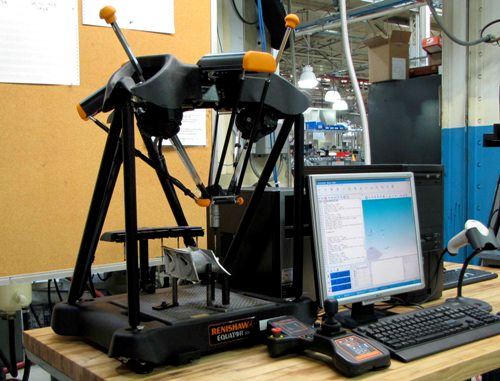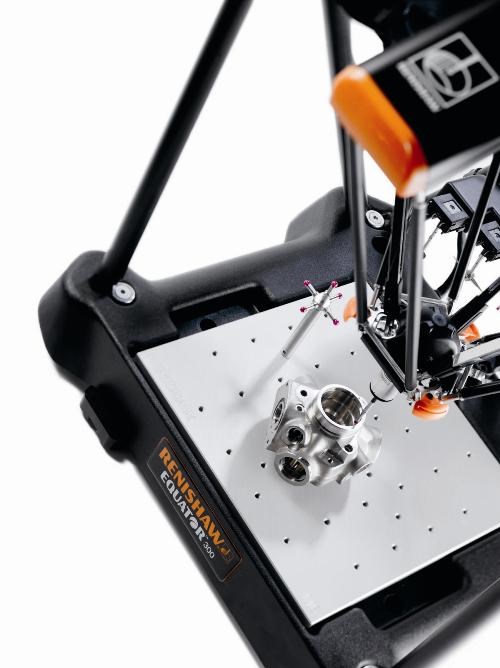In the machining process for a complex and valuable production part, the workpiece is often removed from a flexible, programmable CNC machine tool, only to be inspected using a custom gage that is not flexible or programmable at all. “Hard” gaging—meaning measurement devices on the production floor designed and built for specific parts—provides a way to quickly inspect a workpiece near the machine. Yet hard gaging can also be costly. For jet engine component maker Meyer Tool in Cincinnati, Ohio, designing, building and maintaining a hard gage could cost $20,000, according to quality manager Beau Easton. If a design change to the part necessitates a change to the gage, then this could add thousands of dollars more.
Renishaw, the metrology technology specialist with U.S. headquarters in Hoffman Estates, Illinois, recently introduced a new gaging system—not to mention a different idea in gaging—that is aimed at reducing these gaging-related costs. The company’s “Equator” system is built around a programmable, parallel kinematic measurement unit that rapidly compares a newly machined part to a reliable dimensional master. Meyer Tool is one of the earliest users of this approach to shopfloor inspection. By applying the Equator system within a newly developed work cell, the manufacturer avoided the need for at least four hard gages.
The Equator measurement device resembles a small coordinate measuring machine (CMM), in that it measures part features in three dimensions by touching them with a probe. The similarity ends there. The device not only fills a role in the process very different from that of a CMM, but it also relies on a CMM—because CMM inspection is likely to be the source of the Equator’s measurement traceability. Instead of promising to be accurate the way a CMM does, the Equator promises to be repeatable. This difference is important, because the key to accurate gaging with the Equator system is to begin with an accurately measured master component.
This master’s dimensions are established, one time, away from temperature variations and other shopfloor effects using an accurate measurement system such as a CMM in a temperature-controlled room. Then, so long as the master part is similar to the production part in terms of size and features, and also made of the same material, it can be trusted to serve as a reliable guide to the environmental-related changes of the actual part. For example, if the workpiece has expanded because of a hot day in the production area, the master will have expanded by the same proportion. “Zeroing” the Equator by measuring this master will therefore remove the workpiece’s thermal expansion as a factor affecting the measured accuracy of the part.
This zeroing is similar to the way a hard gage is zeroed. Periodically measuring the master corrects for any drift in the precision of the process. Meyer Tool keeps its own gaging process precise on the Equator by re-measuring the master every 3 hours. For either the master or a production part, this measurement cycle is fast, thanks in part to the device’s parallel kinematic structure. At Meyer Tool, measurement cycles take 2 to 6 minutes, depending on part complexity. Using a continuous-contact scanning probe (which Meyer does not do, but plans to) would let the Equator system capture thousands of data points per feature within cycles this brief.
Meyer Tool SPC manager Bridget Nolan says, “We are doing GD&T true positions, notches, hole diameters, profiles and runout” using the Equator system. The programs that are run in this shop use at least four different probe styli. A changing rack allows the unit to switch styli automatically.
Software for the system comes in two levels. Engineers use a programmable version to create inspection programs. In production, a streamlined version lets the operator easily select the right program to initiate inspection.
Changing between part numbers involves simply changing the fixture tile on the Equator device. Meyer Tool keeps various inspection setups ready on different tiles. Formerly, in place of this selection of tiles, the shop would have needed various individual hard gages for different parts. Now, parts with extremely different features can be measured on the same gage, just by swapping the setup in seconds, and quickly zeroing the gage with the appropriate master part.























.png;maxWidth=300;quality=90)





